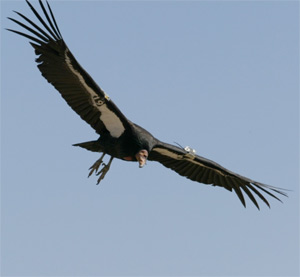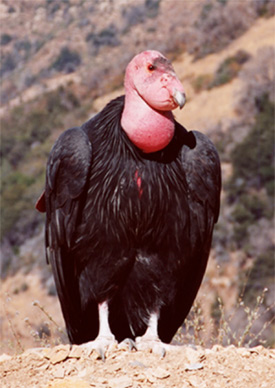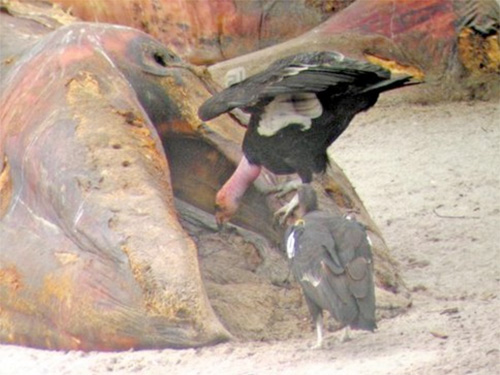
FACTS
- Condors and vultures lack feathers on their heads to reduce the chance of contracting diseases from bacteria associated with carrion. They often insert their heads into carcasses to access tissue. In spite of the lack of feathers, they spend time cleaning their heads and feathers after eating.
- The skin on a California Condor’s head can vary from yellow to red and is believed to change according to its behavior.
- California Condors ride thermal updrafts to altitudes of 4500 m, and can reach speeds of 88 kph (San Diego Zoo, 2008).

Periodically gray whale (Eschrichtius robustus) carcasses wash ashore on California beaches. In some cases, the endangered California Condor (Gymnogyps californianus) feeds on these gray whale carcasses. Wildlife biologists from the Ventana Wilderness Society (VWS) have observed up to 5 individuals fee
ding upon a beached gray whale during the Summer of 2006. California Condors are more frequently appearing along the Big Sur coast. California Condors have not been observed feeding on whale remains since the Lewis and Clark Expedition in 1806. These birds have also allegedly been feeding on Southern sea otter (Enhydra lutris nereis) and California sea lion (Zalophus californianus) carcasses. According to senior wildlife biologist Joe Burnett of the VWS, these feeding events mark important milestones for the species as the birds are becoming more self-sufficient (Thorton, 2006).
California Condors are scavengers, feeding exclusively on carrion (the flesh of dead animals). They have the longest wingspan (up to 3 m), and are the heaviest of birds (weighing up to 12 kg) in North America. They are also among the longest-lived species of birds, with some individuals surviving 60 years. Historically, the California Condor’s range extended along the Pacific coast from British Columbia in Canada to central Mexico (San Diego Zoo, 2008). However, poaching, lead poisoning, and human encroachment caused their numbers and range to plummet to near extinction. In 1975, the California Condor Recovery Program was initiated to save the species from extinction. The goal of the program was to raise and breed the remaining individuals in captivity with the hope of eventually establishing wild populations.
To learn more about the California Condor, please click here to visit the SIMoN Species Database.

|
|